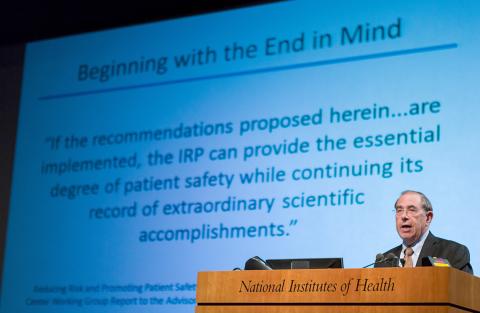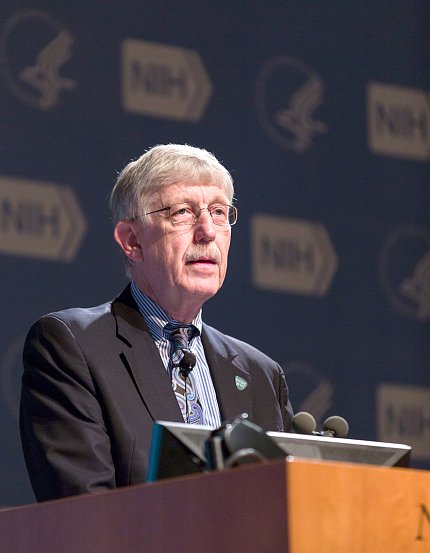No ‘Sugar-Coating’
New Oversight Coming to Clinical Center, Intramural Research

Photo: Daniel Soñé
Sometimes, hospitals themselves have to take medicine. That was the conclusion of a working group of the advisory committee to the NIH director whose 11 recommendations about Clinical Center management were unanimously accepted by the ACD and then immediately acted upon by NIH director Dr. Francis Collins on Apr. 21.
The next morning, Collins, CC director Dr. John Gallin and NIH deputy director for intramural research Dr. Michael Gottesman presented the so-called “Red Team’s” findings to the intramural community at a town hall meeting in Masur Auditorium. They assured employees that steps taken to address shortcomings identified almost a year ago in the CC’s pharmaceutical development section (PDS) will result in renewed emphasis on patient safety and continuation of world-class research.
The issue that led to what Collins characterized as a nearly year-long period of therapeutic “soul searching” at NIH was a CC pharmacy department employee’s complaint to the FDA in May 2015 about procedures involving sterile injectables. The whistleblower, lauded as “something of a hero,” by Gallin, exposed a culture wherein overworked PDS employees, struggling to please researchers, sometimes cut corners in the rush to provide products, then found that complaints to superiors about the situation never rose to top CC management.
NIH responded quickly to the complaint last summer, and in the process of reviewing sterile procedures discovered that the CC pharmacy, opened 10 years ago in the Clinical Research Center, never received certification under Good Manufacturing Practices criteria; it had only a certificate of occupancy, said Norm Augustine, former CEO of Lockheed Martin and Red Team chair.

Photo: Daniel Soñé
“I must point out that no one was intentionally negligent or indifferent,” said Augustine. “In fact it was quite the opposite. They were extremely dedicated.” But the zeal to answer any and all requests for products “sometimes involved cutting corners.”
The Red Team found that NIH’s “strong commitment to research has inadvertently” been in conflict with safety standards. He cautioned, “You can’t have one at the expense of the other, even to a small degree.”
Augustine, who said his team has “not tried to sugar-coat anything,” emphasized that putting patient safety secondary to research needs was never done consciously. He added, “We would all [Red Team members] go to the Clinical Center without any hesitation if the need arose.” Of the whistleblower he said, “That person should be commended.”

Photo: Daniel Soñé
Collins underscored repeatedly that no patients were harmed as a result of the safety lapses, and that the patients, all of whom were notified right away, would continue to be followed for any sign of trouble. NIH immediately closed the sterile part of the PDS last summer and has now decided not to rebuild it, citing an estimated cost of $50 million as too high.
For the moment, investigators’ needs for sterile injectables are being met by an NCI facility in Frederick. Gottesman said non-sterile PDS products remain on hand in sufficient amounts, but new sources will be needed soon for them.
The PDS problems prompted a thorough review of 11 other NIH facilities that prepare sterile products for patient use; that study remains ongoing. In its wake, an NCI laboratory involved in immunotherapy and an NIMH lab that uses PET tracers have temporarily shut down operations related to the products.
“This is a fantastic example of how to face problems head-on,” said ACD member Dr. Cori Bargmann of the Rockefeller University.
“I want to thank the Red Team and the ACD for a job well done,” said Collins. “This has been a difficult period for us, but we want to look forward, not backward.” He put NIH principal deputy director Dr. Lawrence Tabak, NIH deputy director for science, outreach and policy Dr. Kathy Hudson and Gottesman in charge of enforcing a set of changes he announced immediately.
These include:
- Creation of an external hospital board that will meet quarterly, chaired by Dr. Laura Forese, executive vice president and chief operating officer at New York-Presbyterian Hospital. She is an expert in the field who already oversees 6 major hospitals in the greater New York area, said Gottesman, and has committed to 2 years of work with NIH.
- Creation of a new compliance office within the Office of Intramural Research, with oversight not just of the CC, but of the entire IRP. Its interim director will be Dr. Kathryn Zoon, who was lured out of retirement plans. Collins lauded her as the best possible person for the job, having headed FDA’s Center for Biologics Evaluation Research and having served as scientific director at NIAID.
- Hiring two companies with expertise in safety and compliance to assess all facilities involved in creation of sterile products at NIH.
- Modifying the performance plans of all who have patient-care responsibility, to include a critical element on safety and compliance with regulations.
In the longer term, Collins said he’s certain NIH “can achieve essential patient safety without slowing down advances in research…This is going to be top-of-the-list for us…Patients who come to the Clinical Center can be confident that they are getting the best possible care.”
He assured employees at the town hall meeting that they are valued.

Photo: Daniel Soñé
“I want to make one thing absolutely clear,” he said. “The Clinical Center staff is simply top notch, each and every one of you…I receive countless notes of thanks from patients…Thanks to you, many lives have been saved and many more will be saved in the future.”
Collins acknowledged that the coming changes “won’t be easy. There may be a few bumps. But having seen you all in action, I think you’re totally up to the challenge…I have the utmost confidence that this is an opportunity for growth. Together, I know we can do it.”
Gallin said that when the Clinical Research Center opened, “we instituted the word ‘sharing.’ We are now extending that sharing to efforts to improve safety.” He said he read the Red Team report 4 times, “and I think the recommendations are really, really good…I believe in my heart that implementation is really a good thing.”
Gottesman said a detailed implementation plan for Red Team recommendations would be unveiled by May 21. “I’ve been here long enough to know that NIH can survive this,” he concluded.
During a Q&A session with employees, Gallin noted that while the culture change called for in the recommendations “is free [of charge], it is also hard to do. No patient should be scared of going here.” Collins also pointed out that the CC’s current advisory board for clinical research, “which has been in place for some time,” will be “sunsetted” in favor of more stringent external board oversight that is common in community hospitals nationwide.
More on Red Team recommendations can be found at https://acd.od.nih.gov/meetings/meetings2011-2016.html, under the Apr. 21, 2016 heading.
